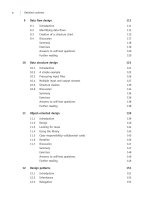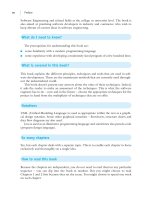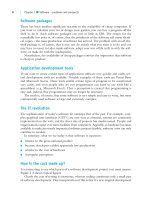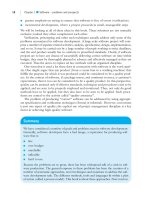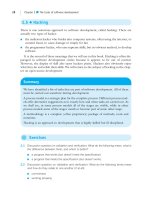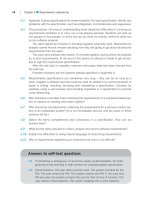Software Engineering For Students: A Programming Approach Part 16 pdf
Bạn đang xem bản rút gọn của tài liệu. Xem và tải ngay bản đầy đủ của tài liệu tại đây (161.16 KB, 10 trang )
128 Chapter 10 ■ Data structure design
*
Body
Record
TrailerHeader
Issue Receipt
Batch
Input
file
*
*
Figure 10.8 Data structure diagram for input file
Total
Report
*
Figure 10.9 Data structure diagram for report
Consider the following problem:
A serial file describes issues and receipts of stock. Transactions are grouped into batches. A
batch consists of transactions describing the same stock item. Each transaction describes
either an issue or a receipt of stock. A batch starts with a header record and ends with a
trailer record. Design a program to create a summary report showing the overall change
in each item. Ignore headings, new pages, etc. in the report.
The data structure diagrams are given in Figures 10.8 and 10.9.
We now look for correspondences between the two diagrams. In our example, the
report (as a whole) corresponds to the input file (as a whole). Each summary line in
the report matches a batch in the input file. So we can draw a single, composite pro-
gram structure diagram as in Figure 10.10.
BELL_C10.QXD 1/30/05 4:22 PM Page 128
10.4 Multiple input and output streams 129
Writing down operations, attaching them to the program structure diagram (not
shown) and translating into pseudo-code, gives:
open files
read header record
while not end of file
do
total = 0
read record
while not end of batch
do
update total
read record
endwhile
display total
read header record
endwhile
close files
Thus we have seen that, where a program processes more than one file, the method
is essentially unchanged – the important step is to see the correspondences between the
file structures and hence derive a single compatible program structure.
Process
body
Process
record
Process
header
Process
trailer
Process
issue
Process
receipt
Process batch
produce total
*
*
Process file
produce report
Figure 10.10 Program structure diagram for processing batches
>
>
BELL_C10.QXD 1/30/05 4:22 PM Page 129
130 Chapter 10 ■ Data structure design
In a minority of problems, the two or more data structures involved cannot be
mapped onto a single program structure. The method terms this a structure clash.
It happens if we try to use the method to design a program to solve the following
problem.
Design a program that inputs records consisting of 80 character lines of words and
spaces. The output is to be lines of 47 characters, with just one space between words.
This problem looks innocuous enough, but it is more complex than it looks. (Have
a go if you don’t agree!) A problem arises in trying to fit words from the input file neat-
ly into lines in the output file. Figures 10.11 and 10.12 show the data structure dia-
grams for the input and output files. Superficially they look the same, but a line in the
input file does not correspond to a line in the output file. The two structures are fun-
damentally irreconcilable and we cannot derive a single program structure. This situa-
tion is called a structure clash.
Although it is difficult to derive a single program structure from the data structure
diagrams, we can instead visualize two programs:
■ program 1, the breaker, that reads the input file, recognizes words and produces
a file that consists just of words.
■ program 2, the builder, that takes the file of words created by program 1 and
builds it into lines of the required width.
We now have two programs together with a file that acts as an intermediary between
the programs.
10.5 ● Structure clashes
Input
file
Line
*
Figure 10.11 Data structure diagram for input file
*
Output
file
Line
*
Figure 10.12 Data structure diagram for output file
BELL_C10.QXD 1/30/05 4:22 PM Page 130
10.5 Structure clashes 131
As seen by the breaker, Figure 10.13 shows the data structure diagram for the
intermediate file, and it is straightforward to derive the program structure diagram
(Figure 10.14).
Similarly, Figure 10.15 shows the structure of the intermediate file as seen by the
second program, the
builder, and again it is easy to derive the program structure dia-
gram for program 2, the
builder (Figure 10.16).
Thus, by introducing the intermediate file, we have eradicated the structure clash.
There is now a clear correspondence both between the input file and the intermediate
file and between the intermediate file and the output file. You can see that choosing a
suitable intermediate file is a crucial decision.
From the program structure diagrams we can derive the pseudo-code for each of the
two programs:
program 1 (the breaker)
open files
read line
while not end of file do
while not end of line do
extract next word
write word
endwhile
read next line
endwhile
close files
Intermediate
file
Word
*
Figure 10.13 Data structure diagram for the intermediate file (as seen by the breaker)
Process input
produce
intermediate
Process
line
*
Process
word
*
Figure 10.14 Program structure diagram for the breaker program
>
>
BELL_C10.QXD 1/30/05 4:22 PM Page 131
132 Chapter 10 ■ Data structure design
To avoid being distracted by the detail, we have left the pseudo-code with operations
such as
extract word in it. Operations like this would involve detailed actions on array
subscripts or on strings.
program 2 (the builder)
open files
read word
while more words
do
while line not full
and more words
do
insert word into line
read word
endwhile
output line
endwhile
close files
We began with the need to construct a single program. In order to eliminate the
structure clash, we have instead created two programs, plus an intermediate file, but at
least we have solved the problem in a fairly systematic manner.
Intermediate
file
Word
*
Figure 10.15 Data structure diagram for the intermediate file (as seen by the builder)
Process
intermediate
produce
output
Process
line
*
Input
word
*
Figure 10.16 Program structure diagram for the builder program
>
>
BELL_C10.QXD 1/30/05 4:22 PM Page 132
10.5 Structure clashes 133
Let us review the situation so far. We drew the data structure diagrams, but then saw
the clash between the structures. We resolved the situation by identifying two separate
programs that together perform the required task. Next we examine the two file struc-
tures and identify a component that is common to both. (In the example program this
is a word of the text.) This common element is the substance of the intermediate file
and is the key to dealing with a structure clash.
What do we do next? We have three options open to us.
First, we might decide that we can live with the situation – two programs with an
intermediate file. Perhaps the overhead of additional input-output operations on the
intermediate file is tolerable. (On the other hand, the effect on performance might be
unacceptable.)
The second option requires special operating system or programming language facil-
ities. For example, Unix provides the facility to construct software as collections of pro-
grams, called filters, that pass data to and from each other as serial streams called pipes.
There is minimal performance penalty in doing this and the bonus is high modularity.
For the above problem, we write each of the two programs and then run them with
a pipe in between, using the Unix command:
breaker < InputFile | builder > OutputFile
or the DOS command:
InputFile | breaker | builder > OutputFile
in which the symbol | means that the output from the filter (program) breaker is used
as input to the program (filter)
builder.
The third and final option is to take the two programs and convert them back into
a single program, eliminating the intermediate file. To do this, we take either one and
transform it into a subroutine of the other. This process is known as inversion. We will
not pursue this interesting technique within this book.
On the face of it, structure clashes and program inversion seem to be very compli-
cated, so why bother? Arguably structure clashes are not an invention of the data struc-
ture design method, but a characteristic inherent in certain problems. Whichever
method that was used to design this program, the same essential characteristic of the
problem has to be overcome. The method has therefore enabled us to gain a funda-
mental insight into problem solving.
In summary, the data structure design method accommodates structure clashes like
this. Try to identify an element of data that is common to both the input file and the
output file. In the example problem it is a word of text. Split the required program into
two programs – one that converts the input file into an intermediate file that consists
of the common data items (words in our example) and a second that converts the inter-
mediate file into the required output. Now each of the two programs can be designed
according to the normal data structure design method, since there is no structure clash
BELL_C10.QXD 1/30/05 4:22 PM Page 133
134 Chapter 10 ■ Data structure design
in either of them. We have now ended up with two programs where we wanted only
one. From here there are three options open to us:
1. tolerate the performance penalties
2. use an operating system or programming language that provides the facility for
programs to exchange serial streams of data
3. transform one program into a subroutine of the other (inversion).
Principles
The basis of the data structure design method is this. What a program is to do, its spec-
ification, is completely defined by the nature of its input and output data. In other
words, the problem being solved is determined by this data. This is particularly evident
in information systems. It is a short step to saying that the structure of a program
should be dictated by the structure of its inputs and outputs. Specification determines
design. This is the reasoning behind the method.
The hypothesis that program structure and data structure can, and indeed should,
match constitutes a strong statement about the symbiotic relationship between actions
and data within programs. So arguably, this method not only produces the best design
for a program, but it creates the right design.
The correspondence between the problem to be solved (in this case the structure of
the input and output files) and the structure of the program is termed proximity. It has
an important implication. If there is a small change to the structure of the data, there
should only need to be a correspondingly small change to the program. And vice versa –
if there is a large change to the structure of the data, there will be a correspondingly large
change to the program. This means that in maintenance, the amount of effort needed will
match the extent of the changes to the data that are requested. This makes a lot of sense
to a client who has no understanding of the trials involved in modifying programs. Sadly
it is often the case that someone (a user) requests what they perceive as a small change to
program, only to be told by the developer that it will take a long time (and cost a lot).
Degree of systematization
The data structure design method can reasonably claim to be the most systematic pro-
gram design method currently available. It consists of a number of distinct steps, each
of which produces a definite piece of paper. The following claims have been made of
the method:
■ non-inspirational – use of the method depends little or not at all on invention or
insight
■ rational – it is based on reasoned principles (structured programming and program
structure based on data structure)
10.6 ● Discussion
BELL_C10.QXD 1/30/05 4:22 PM Page 134
10.6 Discussion 135
■ teachable – people can be taught the method because it consists of well-defined steps
■ consistent – given a single program specification, two different people will come up
with the same program design.
■ simple and easy to use
■ produces designs that can be implemented in any programming language.
While these characteristics can be regarded as advantages, they can also be seen as a
challenge to the traditional skills associated with programming. It is also highly con-
tentious to say that data structure design is completely non-inspirational and rational.
In particular, some of the steps arguably require a good deal of insight and creativity,
for example, drawing the data structure diagram, identifying the elementary operations
and placing the operations on the program structure diagram.
Applicability
Data structure design is most applicable in applications where the structure of the
(input or output) data is very evident. Where there is no clear structure, the method
falls down.
For example, we can assess how useful this method is for designing computational
programs by considering an example. If we think about a program to calculate the
square root of a number, then the input has a very simple structure, and so has the out-
put. They are both merely single numbers. There is very little information upon which
to base a program structure and no guidance for devising some iterative algorithm that
calculates successively better and better approximations to the solution. Thus it is
unlikely that data structure design can be used to solve problems of this type.
The role of data structure design
Data structure design’s strong application area is serial file processing. Serial files are wide-
ly used. For example, graphics files (e.g. JPEG and GIF formats), sound files (e.g. MIDI),
files sent to printers (e.g. PostScript format), Web pages using HTML, spreadsheet files
and word processor files. Gunter Born’s book (see Further Reading) lists hundreds of
(serial) file types that need the programmer’s attention. So, for example, if you needed to
write a program to convert a file in Microsoft format to an Apple Macintosh format, data
structure design would probably be of help. But perhaps the ultimate tribute to the
method is the use of an approach used in compiler writing called recursive descent. In
recursive descent the algorithm is designed so as to match the structure of the program-
ming language and thus the structure of the input data that is being analyzed.
The main advantages of data structure design are:
■ there is high “proximity” between the structure of the program and the structure of
the files. Hence a minor change to a file structure will lead only to a minor change
in the program
■ a series of well-defined steps leads from the specification to the design. Each stage
creates a well-defined product.
BELL_C10.QXD 1/30/05 4:22 PM Page 135
136 Chapter 10 ■ Data structure design
10.1 Design a program to display a multiplication table such as young children use. For
example, the table for numbers up to 6 is:
1 23456
11 23456
22 4681012
3 3 6 9 12 15 18
4 4 812162024
5 5 10 15 20 25 30
6 6 12 18 24 30 36
The program should produce a table of any size, specified by an integer input from a
text box. (The structure of the input is irrelevant to this design.)
10.2 A data transmission from a remote computer consists of a series of messages. Each
message consists of:
1. a header, which is any number of SYN bytes
Summary
The basis of the data structure method is that the structure of a program can be
derived from the structure of the files that the program uses. The method uses a dia-
grammatic notation for file and program structures. Using these diagrams, the method
proceeds step by step from descriptions of the file structures to a pseudo-code design.
The steps are:
1. draw a diagram (a data structure diagram) describing the structure of each of
the files that the program uses.
2. derive a single program structure diagram from the set of data structure
diagrams.
3. write down the elementary operations that the program will have to carry out.
4. associate the elementary operations with their appropriate positions in the pro-
gram structure diagram
5. transform the program structure diagram into pseudo-code.
In some cases, a problem exhibits an incompatibility between the structures of
two of its inputs or outputs. This is known as a structure clash. The method incor-
porates a scheme for dealing with structure clashes.
Exercises
•
BELL_C10.QXD 1/30/05 4:22 PM Page 136
Exercises 137
2. a control block, starting with an F4 (hexadecimal) byte, and ending with F5
(hexadecimal). It contains any number of bytes (which might be control informa-
tion, e.g. to open an input-output device).
3. any number of data bytes, starting with F1 (hexadecimal), and ending with F2
(hexadecimal).
Messages must be processed in this way:
■ store any control bytes in an array. When the block is complete, call an already
written method named obeyControl
■ every data byte should be displayed on the screen
Assume that a readByte operation is available to obtain a byte from the remote
computer.
10.3 Compare and contrast the principles behind the following design methods:
■ functional decomposition
■ data structure design
■ data flow design
■ object oriented design.
10.4 Some proponents of the data structure design method claim that it is “non-inspirational”.
How much inspiration do you think is required in using the method?
10.5 Assess the advantages and disadvantages of data structure design.
10.6 Suggest facilities for a software tool that could assist in or automate using data struc-
ture design.
10.7 Evaluate data structure design under the following headings:
■ special features and strengths
■ weaknesses
■ philosophy/perspective?
■ systematic?
■ appropriate applications
■ inappropriate applications
■ is the method top-down, bottom-up or something else?
■ good for large-scale design?
■ good for small-scale design?
■ can tools assist in using the method?
BELL_C10.QXD 1/30/05 4:22 PM Page 137


